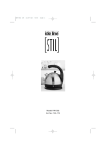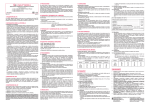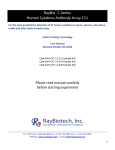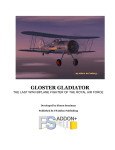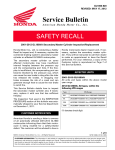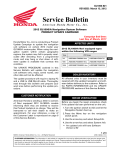Download AssayMaxTM Human Protein C ELISA Kit
Transcript
AssayMaxTM Human Protein C ELISA Kit Assaypro LLC 3400 Harry S Truman Blvd St. Charles, MO 63301 T (636) 447-9175 F (636) 395-7419 www.assaypro.com For any questions regarding troubleshooting or performing the assay, please contact our support team at [email protected]. Thank you for choosing Assaypro. Assay Summary Step 1. Add 25 µl of Standard or Sample and 25 µl of Biotinylated Protein per well. Incubate 2 hours. Step 2. Wash, then add 50 µl of SP Conjugate per well. Incubate 30 minutes. Step 3. Wash, then add 50 µl of Chromogen Substrate per well. Incubate 15 minutes. Step 4. Add 50 µl of Stop Solution per well. Read at 450 nm immediately. Symbol Key Consult instructions for use. H G F E D C B A 1 2 3 4 5 6 7 8 9 10 11 12 Assay Template Human Protein C ELISA Kit Catalog No. EP1311-1 Sample insert for reference use only Introduction Protein C is a vitamin K-dependent plasma antithrombotic and antiinflammatory zymogenic glycoprotein that is synthesized in the liver. Protein C has a light chain of 155 amino acids (21 kDa) and a heavy chain of 262 amino acids (41 kDa) linked by a disulfide bond. On endothelial cell membrane, thrombin-thrombomodulin complex cleaves a 12-residue peptide from protein C amino terminus of the heavy chain and converts it to activated protein C (APC). APC inactivates coagulation Factor Va and Factor VIIIa and performs a major role in regulating blood clotting, inflammation, and apoptosis (1-7). Principle of the Assay The AssayMax Human Protein C ELISA (Enzyme-Linked Immunosorbent Assay) kit is designed for detection of human protein C in plasma and serum samples. This assay employs a quantitative competitive enzyme immunoassay technique that measures human protein C in less than 3 hours. A polyclonal antibody specific for human protein C has been pre-coated onto a 96-well microplate with removable strips. Protein C in standards and samples is competed with a biotinylated protein C sandwiched by the immobilized antibody and streptavidin-peroxidase conjugate. All unbound material is washed away and a peroxidase enzyme substrate is added. The color development is stopped and the intensity of the color is measured. Caution and Warning This product is for Research Use Only and is Not For Use In Diagnostic Procedures. Prepare all reagents (working diluent buffer, wash buffer, standard, biotinylated protein, and SP conjugate) as instructed, prior to running the assay. Prepare all samples prior to running the assay. The dilution factors for the samples are suggested in this insert. However, the user should determine the optimal dilution factor. Spin down the SP conjugate vial before opening and using contents. The Stop Solution is an acidic solution. The kit should not be used beyond the expiration date. 1 Reagents Human Protein C Microplate: A 96-well polystyrene microplate (12 strips of 8 wells) coated with a polyclonal antibody against human protein C. Sealing Tapes: Each kit contains 3 precut, pressure sensitive sealing tapes that can be cut to fit the format of the individual assay. Human Protein C Standard: Human protein C standard in a buffered protein base (4.5 g, lyophilized). Biotinylated Human Protein C: 1 vial, lyophilized. EIA Diluent Concentrate (10x): A 10-fold concentrated buffered protein base (30 ml). Wash Buffer Concentrate (20x): A 20-fold concentrated buffered surfactant (30 ml). Streptavidin-Peroxidase Conjugate (SP Conjugate): A 100-fold concentrate (80 l). Chromogen Substrate: A ready-to-use stabilized peroxidase chromogen substrate tetramethylbenzidine (8 ml). Stop Solution: A 0.5 N hydrochloric acid to stop the chromogen substrate reaction (12 ml). Storage Condition Upon arrival, immediately store components of the kit at recommended temperatures up to the expiration date. Store SP Conjugate at -20°C. Store Microplate, Diluent Concentrate (10x), Wash Buffer, Stop Solution, and Chromogen Substrate at 2-8°C. Unused microplate wells may be returned to the foil pouch with the desiccant packs and resealed. May be stored for up to 30 days in a vacuum desiccator. Diluent (1x) may be stored for up to 30 days at 2-8°C. Store Standard and Biotinylated Protein at 2-8°C before reconstituting with Diluent and at -20°C after reconstituting with Diluent. Other Supplies Required Microplate reader capable of measuring absorbance at 450 nm. Pipettes (1-20 l, 20-200 l, 200-1000 l, and multiple channel). Deionized or distilled reagent grade water. Sample Collection, Preparation, and Storage 2 Plasma: Collect plasma using one-tenth volume of 0.1 M sodium citrate as an anticoagulant. Centrifuge samples at 3000 x g for 10 minutes. Dilute samples 1:8 into EIA Diluent and assay. The undiluted samples can be stored at -20°C or below for up to 3 months. Avoid repeated freezethaw cycles (EDTA or Heparin can also be used as an anticoagulant). Serum: Samples should be collected into a serum separator tube. After clot formation, centrifuge samples at 3000 x g for 10 minutes, and remove serum. Dilute samples 1:8 into EIA Diluent and assay. The undiluted samples can be stored at -20°C or below for up to 3 months. Avoid repeated freeze-thaw cycles. Reagent Preparation Freshly dilute all reagents and bring all reagents to room temperature before use. EIA Diluent Concentrate (10x): If crystals have formed in the concentrate, mix gently until the crystals have completely dissolved. Dilute the EIA Diluent Concentrate 1:10 with reagent grade water. Store for up to 30 days at 2-8°C. Standard Curve: Reconstitute the 4.5 g of Human Protein C Standard with 0.75 ml of EIA Diluent to generate a 6 g/ml standard solution. Allow the standard to sit for 10 minutes with gentle agitation prior to making dilutions. Prepare duplicate or triplicate standard points by serially diluting the standard solution (6 g/ml) 1:2 with EIA Diluent to produce 3, 1.5, 0.75, 0.375, 0.188, and 0.094 g/ml solutions. EIA Diluent serves as the zero standard (0 g/ml). Any remaining solution should be frozen at -20°C and used within 30 days. Standard Point P1 P2 P3 P4 P5 P6 P7 P8 Dilution Standard (6 g/ml) 1 part P1 + 1 part EIA Diluent 1 part P2 + 1 part EIA Diluent 1 part P3 + 1 part EIA Diluent 1 part P4 + 1 part EIA Diluent 1 part P5 + 1 part EIA Diluent 1 part P6 + 1 part EIA Diluent EIA Diluent [Protein C] (µg/ml) 6.000 3.000 1.500 0.750 0.375 0.188 0.094 0.000 Biotinylated Human Protein C (2x): Reconstitute Biotinylated Human Protein C with 4 ml EIA Diluent to produce a 2-fold stock solution. Allow to sit for 10 minutes with gentle agitation prior to making dilutions. The stock solution should be further diluted 1:2 with EIA Diluent. Any remaining solution should be frozen at -20°C and used within 30 days. Wash Buffer Concentrate (20x): If crystals have formed in the concentrate, mix gently until the crystals have completely dissolved. Dilute the Wash Buffer Concentrate 1:20 with reagent grade water. 3 SP Conjugate (100x): Spin down the SP Conjugate briefly and dilute the desired amount of the conjugate 1:100 with EIA Diluent. Any remaining solution should be frozen at -20°C. Assay Procedure Prepare all reagents, standard solutions, and samples as instructed. Bring all reagents to room temperature before use. The assay is performed at room temperature (20-25°C). Remove excess microplate strips from the plate frame and return them immediately to the foil pouch with desiccants inside. Reseal the pouch securely to minimize exposure to water vapor and store in a vacuum desiccator. Add 25 l of Human Protein C Standard or sample per well, and immediately add 25 l of Biotinylated Human Protein C to each well (on top of the standard or sample) and mix gently. Cover wells with a sealing tape and incubate for 2 hours. Start the timer after the last addition. Wash five times with 200 l of Wash Buffer manually. Invert the plate each time and decant the contents; hit 4-5 times on absorbent material to completely remove the liquid. If using a machine, wash six times with 300 l of Wash Buffer and then invert the plate, decanting the contents; hit 4-5 times on absorbent material to completely remove the liquid. Add 50 l of Streptavidin-Peroxidase Conjugate to each well and incubate for 30 minutes. Turn on the microplate reader and set up the program in advance. Wash the microplate as described above. Add 50 l of Chromogen Substrate per well and incubate for about 15 minutes or till the optimal blue color density develops. Gently tap plate to ensure thorough mixing and break the bubbles in the well with pipette tip. Add 50 l of Stop Solution to each well. The color will change from blue to yellow. Read the absorbance on a microplate reader at a wavelength of 450 nm immediately. If wavelength correction is available, subtract readings at 570 nm from those at 450 nm to correct optical imperfections. Otherwise, read the plate at 450 nm only. Please note that some unstable black particles may be generated at high concentration points after stopping the reaction for about 10 minutes, which will reduce the readings. Data Analysis 4 Calculate the mean value of the duplicate or triplicate readings for each standard and sample. To generate a standard curve, plot the graph using the standard concentrations on the x-axis and the corresponding mean 450 nm absorbance on the y-axis. The best-fit line can be determined by regression analysis using log-log or four-parameter logistic curve-fit. Determine the unknown sample concentration from the Standard Curve and multiply the value by the dilution factor. Standard Curve The curve is provided for illustration only. A standard curve should be generated each time the assay is performed. H. Protein C Standard Curve OD450 nm 1.0 0.1 10 -1 10 0 10 1 [hProtein C] (g/ml) Performance Characteristics The minimum detectable dose of protein C is typically ~ 0.09 µg/ml. Intra-assay and inter-assay coefficients of variation were 4.8% and 7.3% respectively. 5 Linearity Sample Dilution 1:4 1:8 1:16 Average Percentage of Expected Value (%) Plasma Serum 95% 105% 97% 100% 89% 91% Recovery Standard Added Value Recovery % Average Recovery % 0.1 – 3.0 µg/ml 81 – 108% 96% Cross-Reactivity Species Canine Bovine Monkey Mouse Rat Swine Human Rabbit Cross Reactivity (%) None None <50% None <15% <50% 100% None Reference Value The normal blood level of protein C is ~ 4 µg/ml. References (1) (2) (3) (4) (5) (6) (7) Foster DC et al. (1985) Proc. Natl. Acad. Sci. U.S.A. 82(14):4673-4677 Kisiel W. et al. (1976) Biochemistry 15:4893-4900. Esmon CT and Owen WG (1981) Proc. Natl. Acad. Sci. U.S.A. 78:2249-2252 Witt I et al. (1994) Blood Coagul. Fibrinolysis 5(4):651-653 Dahlback B et al. (1993) Proc. Natl. Acad. Sci. U.S.A. 90:1004-1008 Hansson PO et al. (2000) Arch. Intern. Med. 160:769-774 Mosnier LO et al. (2007) Blood 109(8):3161-3172 Version 1.4R www.assaypro.com • E-mail: [email protected] 6










